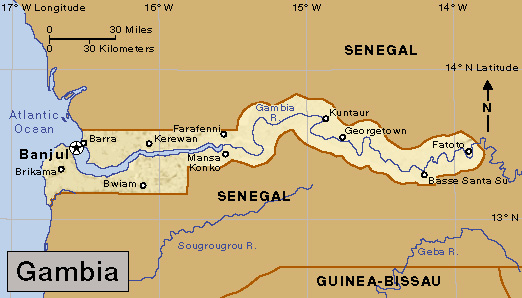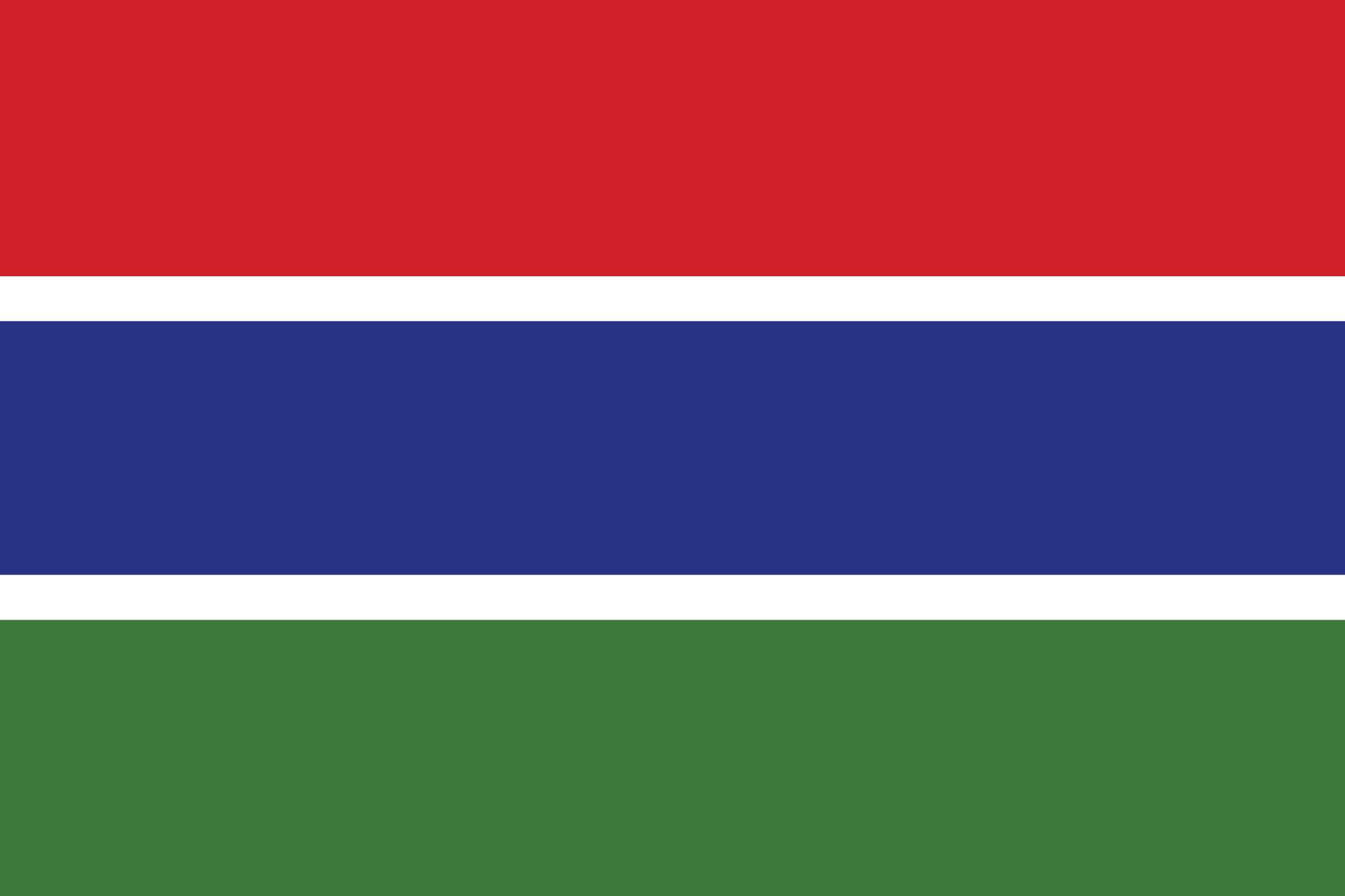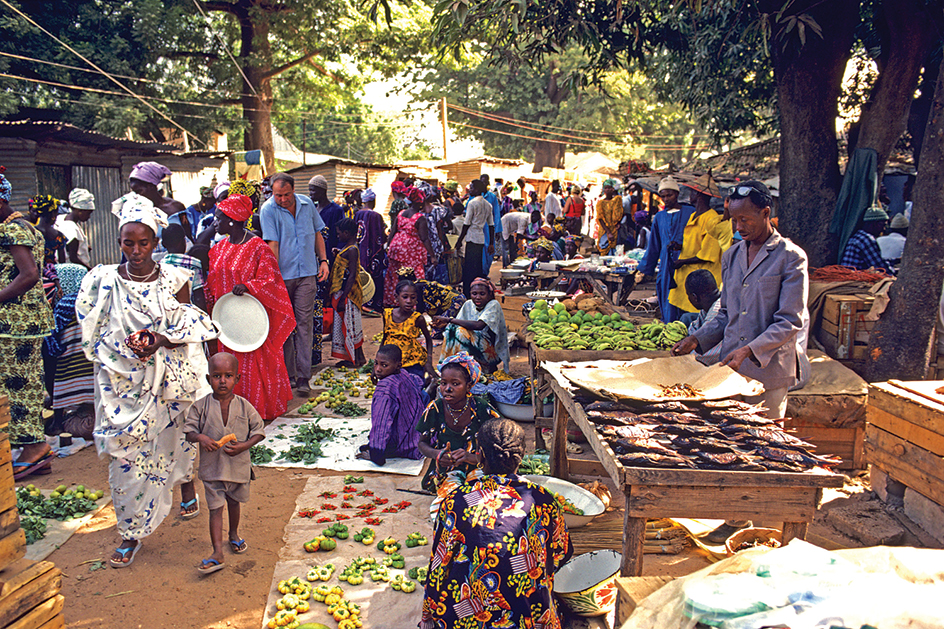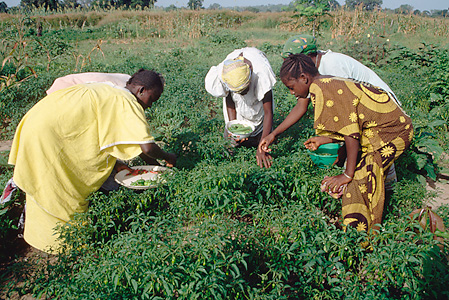Gambia is one of the smallest independent countries in Africa. It is a narrow strip of land that extends inland from the Atlantic Ocean for about 180 miles (290 kilometers). It lies along the banks of the Gambia River. The country is only 15 to 30 miles (24 to 48 kilometers) wide. The Gambia is a flatland. Except for its short coastline, it is entirely surrounded by Senegal. It is officially called the Republic of The Gambia or The Gambia. Banjul, a busy port, is the capital (see Banjul). A paved highway connects Banjul with the town of Brikama, about 20 miles (32 kilometers) to the south. This rapidly urbanizing area, known as the Greater Banjul Area, is home to about 350,000 people.

The Gambia is a poor country. It has little fertile soil. Tropical crops grow well near the mouth of the river. However, most farmers in the Gambia earn a living by raising peanuts and livestock. Tourism is an important source of income for people in the Greater Banjul Area.
James Island, in the Gambia River, was once a slave trading center. From there, slaves were shipped to the Caribbean and America. All or part of what is now the Gambia was controlled by the English from the 1660’s to 1965, when the Gambia became an independent nation.
Government.
In 1996, the Gambia adopted a new constitution. The president of the Gambia is the head of state and is elected by the people to a five-year term. The president appoints the members of the Cabinet to handle the day-to-day operations of government. The National Assembly makes the country’s laws. The people elect most members of the National Assembly to five-year terms. The president appoints a few additional Assembly members. All citizens age 18 and older may vote. The Supreme Court is the Gambia’s highest court.

People.
The Gambia’s five main ethnic groups, in order of size, are the Mandinka, the Fulani, the Wolof, the Serahuli, and the Jola. Most Gambians are Muslims.
The Mandinka live throughout the Gambia. They make a living as traders and peanut farmers. Most of the Fulani live in the eastern part of the country. They raise cattle and grow crops for a living. Some Fulani are nomadic (traveling) people, moving their herds from region to region.

Most Wolof are either farmers who live near the Gambia’s northern border, or inhabitants of Banjul, where they make up a majority of the population. Wolof women in Banjul often dress elegantly for ceremonial occasions. They wear head scarves; high-waisted, full-skirted dresses; and gold ornaments and jewelry.
Most Serahuli live in large villages in eastern Gambia. They farm and raise livestock. Young Serahuli men commonly leave their villages and search for work in Europe or North America. They send part of their earnings back to their families in the villages.
The Jola mainly live in small villages south of the Gambia River near the coast. They have lived in the Gambia longer than the other ethnic groups. They are farmers who raise rice and millet for food. Many Jola follow a traditional African religion practiced by their ancestors.

A majority of Gambian children attend school. Students first attend six years of primary school, known as lower basic. Then they attend three years of upper basic and three years of senior secondary school. The University of The Gambia and Gambia College are in the Greater Banjul Area.
Land.
The Gambia River rises in Guinea and winds through the Gambia before reaching the Atlantic Ocean. Small oceangoing ships can sail up the river from the Atlantic as far as Kuntaur.
Mangrove swamps line the riverbanks from the coast to the center of the country. Behind the swamps lie the banto faros. These areas are firm ground in the dry season, but swamps during the rains. Near the coast, salt water from the tidal reaches of the Gambia River floods the banto faros. The salt water ruins the soil. Farther inland, areas that the river floods with fresh water during the wet season are used to raise rice. Beyond the banto faros, sandy plateaus extend from both sides of the river into Senegal. Farmers raise peanuts, millet, and corn on the plateaus.
The Gambia’s summer months are June through October. Summers are hot and humid. Inland temperatures during the summer may reach 110 °F (43 °C). Winter lasts from November through May. During the winter, temperatures drop to about 60 °F (16 °C). The harmattan, a dry wind, blows from the Sahara during the winter (see Harmattan). About 40 inches (100 centimeters) of rain falls near the coast each year. Inland areas get less rainfall.
Economy.
The Gambia is a poor and underdeveloped country. It has a high unemployment rate, and many of its people live in poverty. Foreign aid and remittances (money sent home) from Gambians working abroad are helpful sources of national income. Tourists from the United Kingdom and other European countries benefit the Gambia’s economy.
About three-fourths of the Gambia’s workers are employed in agriculture. The leading crops include cassava, corn, millet, peanuts, rice, and sorghum. Farmers also raise beef and dairy cattle, chickens, goats, and sheep. Fishing is also important to the Gambia. Manufacturing and mining play small roles in the country’s economy. Manufacturing is primarily based on processing peanuts and other agricultural products.
The Gambia imports more than it exports. Leading imports include food, motor vehicles, and petroleum products. The Gambia has been exporting peanuts since 1830. The country also exports fish and fruits and vegetables. The Gambia’s main trading partners include other African countries, China, and the United States. Banjul has an international airport and the country’s chief port.
History.
The area that is now the Gambia was part of the powerful Mali Empire from the 1200’s to the 1400’s (see Mali Empire). The people raised cotton and rice and other foods. Portugal set up trading posts on the Gambia’s coast in the 1400’s. The coast became a center of the English and Portuguese slave trades during the 1500’s. England began a settlement on James Island in the Gambia River in 1661. During the next 100 years, England and France fought for control of trade on the river.

In 1765, the British established a colony called Senegambia. It included what are now parts of the Gambia and Senegal. In 1783, the British handed over the Senegal territory to France. British merchants founded Bathurst (now Banjul) in 1816. The colony of Gambia was set up in 1888. By 1902, all of what is now the Gambia had come under British rule.
The Gambia began gaining measures of self-government after World War II ended in 1945. It gained complete internal self-government in 1963. David (later Sir Dawda, or Dauda) Jawara became the first prime minister. Jawara was the leader of the People’s Progressive Party. The Gambia gained complete independence on Feb. 18, 1965. On April 24, 1970, the Gambia became a republic. Jawara was elected as the first president.
Under Jawara, the government spent money to improve the Gambia’s roads and ferries. It also worked to modernize Yundum Airport and the harbor at Banjul. Since 1970, tourism in the Gambia has grown rapidly. However, since the 1970’s, occasional droughts have reduced agricultural production and damaged the Gambia’s economy.
In 1982, the Gambia and Senegal formed a confederation. Like the earlier colony, it was called Senegambia. The confederation strengthened the economic ties between the two countries and united their armed forces. However, disputes between the Gambia and Senegal led the two countries to end the confederation in 1989.
In 1994, a group of Gambian military officers led by Yahya Jammeh overthrew Jawara. The officers began to rule the Gambia through a military council. In August 1996, the Gambia adopted a new constitution. Jammeh won presidential elections later that year. Soon after the elections, Jammeh dissolved the military council. In 1997, the Gambia elected a National Assembly. Jammeh was reelected president in 2001, 2006, and 2011. The Jammeh government made improvements in education, health, and agriculture. However, critics expressed concern that Jammeh used his power to silence dissent and restrict freedom of the press and other civil liberties.
Former real estate developer Adama Barrow defeated Jammeh in a 2016 presidential election. After first accepting the outcome, Jammeh later claimed that there were widespread voting irregularities and said that he would challenge the results in court. Jammeh finally agreed to step down after facing growing pressure from the United Nations and the leaders of other African nations. In January 2017, he left the country to live in exile, and Barrow became president. Barrow was reelected in 2021.
